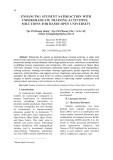
157
HNUE JOURNAL OF SCIENCE
Educational Sciences 2024, Volume 69, Issue 5B, pp. 157-167
This paper is available online at http://stdb.hnue.edu.vn
DOI: 10.18173/2354-1075.2024-0144
CURRENT SITUATION OF COOPERATIVE LEARNING
IN TEACHING STATISTICS AT SECONDARY SCHOOLS
Tran Minh Man* and Le Thai Bao Thien Trung
Department of Mathematics and Informatics, Ho Chi Minh City University of Education,
Ho Chi Minh city, Vietnam
*Corresponding author: Tran Minh Man, e-mail: tranminhmancbl@gmail.com
Received May 24, 2024. Revised November 11, 2024. Accepted December 27, 2024.
Abstract. Cooperative learning (CL) is a teaching approach to develop learners' qualities and
competencies to meet the goals of the 2018 General Education Curriculum. However, in
secondary schools, these days, cooperative learning in mathematics in general, and
specifically in teaching Statistics, has not received adequate attention. As a result,
cooperative learning has not achieved the desired outcome. The paper presents the current
situation of cooperative learning at secondary schools in teaching Statistics by collecting and
analyzing survey data from teachers and suggests insights serving as a basis for proposing
measures to support teachers to implement cooperative learning effectively, contributing to
improving the quality of secondary school education. The research results show that most
teachers consider cooperative learning to be an effective teaching method, yet its use in the
classroom has not been adequate and is still hindered by many difficulties.
Keywords: current situation; cooperative learning; secondary school; teaching statistics.
1. Introduction
Cooperative learning involves students working together through exchanging ideas, solving
problems, or working towards a common goal [1], [2]. Cooperative learning is a learning process
that fulfills multiple educational goals, namely positive interdependence, individual
accountability, mutual interaction, the formation and development of social competencies, as well
as group-based assessment [2], [3]. As a result, cooperative learning is considered an effective
teaching method in today's educational landscape. However, its application to teaching statistical
content is relatively new for educators and poses various challenges in practice. Nguyen and Le
(2020) argue that secondary school mathematics teachers in Vietnam face many challenges as
statistics is being taught for the first time across all educational levels in secondary schools [4].
This is because of the insufficient presence of statistics education in previous teacher training
programs at colleges of education.
Regarding this issue, some researchers have investigated the current state of applying
cooperative learning in mathematics education. Notable examples include Tran Xuan Bo (2016) [5]
and Nguyen Hong Thuy (2018) [6]. These authors examined the application of cooperative
learning in teaching primary school mathematics by teachers in several primary schools in Tuyen
Quang province and Hanoi city. The results revealed that teachers still face many difficulties and
limitations in implementation. However, with the introduction of the 2018 General Education

Tran MM* & Le TBTT
158
Mathematics Curriculum, what challenges will arise in applying cooperative learning in
mathematics teaching in general, and in teaching Statistics in particular? Moreover, can
cooperative learning serve as an effective teaching method to develop learners' qualities and
competencies in alignment with the objectives of the 2018 General Education Program? To better
understand this issue in Bac Lieu province, we conducted a practical teaching survey with 95
secondary school mathematics teachers to provide essential insights for proposing suitable and
effective cooperative learning strategies and models, contributing to the successful
implementation of the 2018 General Education Program's objectives.
2. Content
2.1. Research design
2.1.1. Sampling method
The research survey involved 95 math teachers at secondary schools and high schools (with
secondary school level) in 7 districts, towns, and cities (Bac Lieu city, Gia Rai town, Vinh Loi
district, Hoa Binh district, Phuoc Long district, Hong Dan district, Dong Hai district) in Bac Lieu
province. We also selected a convenient sample of teachers who agreed to answer the
questionnaire in provinces: Soc Trang, and Dong Thap.
2.1.2. Survey purpose
The survey aims to explore the perceptions of secondary school teachers of cooperative
learning and the current state of teaching Statistics content and teaching Statistics through
cooperative learning in the current period.
2.1.3. Data collection procedure and instrument
Figure 1. Survey implementation process
Data collection tool: We used Google's Forms application (Forms) to conduct this survey.
The survey form (or questionnaire) includes 31 questions, the content is presented in Table 1.
Table 1. The main components of the questionnaire
Content
Number
of items
Email, gender, years working in education, highest level of expertise, place
of work, workplace, teaching grade level.
7
Cooperative learning
14
Teaching statistics
6
Teaching statistics through cooperative learning
4
Total
31
2.2. Survey results and discussion
2.2.1. Participants’ demographic information
The total number of teachers participating in the survey was 95 teachers, of which:
- Gender: Male: 53; Female: 42.
Question
design
A priori
analysis
Surveying
Analyze survey
results

Current situation of cooperative learning in teaching statistics at secondary schools
159
- Years of working in education: Under 5 years: 06; From 5 to under 10 years: 09; Over 10
years: 80.
- Highest level of expertise: Masters: 8; University: 86; College: 1.
- Workplace: Inner suburbs, city center: 38; Suburbs and peri-urban areas: 57.
- Teaching grade level: Middle school: 85; Inter-level Middle School - High School: 10.
2.2.2. Evaluating measurement tools
The Cronbach's Alpha reliability coefficient is an important indicator for assessing the
reliability of questionnaires or scales, particularly in social and psychological research. According
to studies by Nunnally (1978) and Peterson (1994), a questionnaire is considered very good if the
Cronbach's Alpha coefficient ranges from 0.8 to nearly 1, and is considered good if it ranges from
0.7 to nearly 0.8 [7], [8].
The reliability coefficient in Table 2 shows that all factors have good Cronbach Alpha coefficients
from 0.735 to 0.947. This means that the questionnaire fulfills the required reliability coefficient.
Table 2. Reliability of the questionnaire
Factor
Number of
variables
Cronbach Alpha
Teachers' perceptions of cooperative learning
(Q1; Q2;Q3;Q4)
4
0.947
Difficulties when organizing cooperative learning
(Q7.1; Q7.2; Q7.3; Q7.4; Q7.5; Q7.6; Q7.7)
7
0.822
Teachers' perceptions of teaching Statistics
(Q9; Q10; Q11; Q12.1; A12.2)
5
0.735
Teachers' perceptions of teaching Statistics through
cooperative learning (Q13; Q14; Q15)
3
0.840
Total
19
(Cronbach Alpha coefficients of each factor were calculated with the IBM SPSS 29 statistical program)
2.2.3. Survey results
* Cooperative learning
✓ Teachers' perceptions of cooperative learning
Table 3. Teachers' perceptions of cooperative learning
Content
Level (%)
Mean
Value
Standard
deviation
1
2
3
4
5
1. Cooperative learning is a way of
organizing teaching in which
students work in groups to research
together, exchange ideas, and solve
problems.
5.26
0
2.11
49.47
43.16
4.25
0.934
2. Cooperative learning has a
number of characteristics involving
group building activities; positive
interdependence; individual and
5.26
0
2.11
58.95
33.68
4.16
0.903

Tran MM* & Le TBTT
160
group responsibilities; and Forming
and developing cooperation skills.
3. Cooperative learning has the
advantage of forming and
developing the following qualities:
compassion, responsibility, and
honesty of learners.
5.26
0
3.16
54.74
36.84
4.18
0.922
4. Cooperative learning has the
advantage of forming and
developing the general competence
for learners: Autonomy and self-
study; problem solving and
creativity; communication and
cooperation. Especially
mathematical competence: solving
mathematical problems; and
mathematical communication.
5.26
0
3.16
50.53
41.05
4.22
0.936
Medium
4.20
The responses were rated on a 5-point Likert scale from 1 to 5 (1-Completely disagree; 2-
Disagree; 3-No opinion; 4-Agree; 5-Completely agree). Completely disagree: 1.81-2.60;
Disagree: 2.61-3.40; Agree: 3.41-4.20; Completely agree: 4.21-5.0 [9].
According to the results observed in Table 3, the mean score for each variable ranges from
4.16 to 4.25; The factor average is 4.20. Of all the 5 levels, "agreement" reached the highest rate
in every variable. It can be said that the surveyed teachers generally had a proper understanding
of the concepts, characteristics, and benefits of cooperative learning. Therefore, cooperative
learning has increasingly been emphasized by teachers, especially since the 2018 general
education curriculum was issued. However, there are still some teachers who have not fully
understood these concepts (who completely disagreed, accounting for 5.26% of teachers).
Teacher awareness is expected to gradually improve with teaching experience and cooperative
learning training. As a result, teachers can better apply these concepts in their teaching process.
✓ Conditions for organizing effective cooperative learning
Figure 2. Conditions for organizing effective cooperative learning activities
58.95
78.95 89.47
0
10
20
30
40
50
60
70
80
90
100
The learning task should be
challenging enough to
facilitate group-based
teaching
The workspace should
ensure suitability for
students to easily engage in
exchanges and discussions
The time allocated should
also be sufficient for team
members to discuss and
effectively present their
results

Current situation of cooperative learning in teaching statistics at secondary schools
161
The survey results show that among the three conditions for organizing effective cooperative
learning, "The time allocated should also be sufficient for team members to discuss and
effectively present their results" is of greatest concern among the teachers (accounting for
89.47%); "The workspace should ensure suitability for students to easily engage in exchanges and
discussions" is their second concern (accounting for 78.95%); Many teachers disagreed with the
statement "The learning task should be challenging enough to facilitate group-based teaching"
(58.95% of teachers disagreed). It can be said that the awareness of some teachers regarding the
conditions for effectively organizing cooperative teaching was not yet comprehensive. This can
be explained either by the fact that those teachers have not been fully equipped with theoretical
knowledge about this issue by the teachers themselves or by the school's conditions, etc.
✓ Conditions for an effective cooperative learning process
Figure 3. Conditions for the cooperative learning process to be effective
As shown from the survey findings, the conditions for the effective cooperative learning
process were highly agreed upon by the teachers (accounting for 67.37% to 85.36% of the
respondents). In particular, "rational grouping and appropriate task allocation for each team
member within and across groups " was considered the most important condition, claimed by
85.36% of the participating teachers. “Positive interdependence " was chosen by the fewest
teachers (accounting for 67.37%). Each condition has its own significance in facilitating an
effective cooperative learning process. Cooperative learning is expected to create positive
interdependence, encouraging students to link and coordinate activities to carry out common tasks
based on the proactive organization of each member. However, some teachers were not fully
aware of modern teaching theories. This situation highlights that, in order to put interactive
teaching into practice and maximize its effectiveness, it is necessary to enhance teachers'
understanding of the essence of cooperative learning and to provide more specific pedagogical
guidance and support for teachers.
✓ Difficulties in organizing cooperative learning
78.95 82.11
67.37 70.53
85.36
70.53
0
10
20
30
40
50
60
70
80
90
The learning
purpose is
clearly defined
The
participating
members have a
high sense of
responsibility
There is a
positive
interdependence
The formation
of cooperative
motivation
The rational
grouping and
appropriate task
allocation for
each team
member within
and across
groups
There is
coordination
among tasks






![Tài liệu hướng dẫn làm bài tập lớn [chuẩn nhất/chi tiết]](https://cdn.tailieu.vn/images/document/thumbnail/2025/20250703/quang.nguyenthanhquang@hcmut.edu.vn/135x160/646_tai-lieu-huong-dan-lam-bai-tap-lon.jpg)
![Câu hỏi ôn tập Phương pháp nghiên cứu khoa học [chuẩn nhất]](https://cdn.tailieu.vn/images/document/thumbnail/2025/20250702/kimphuong555/135x160/7611751422396.jpg)
![Câu hỏi ôn tập môn Phương pháp nghiên cứu [năm]](https://cdn.tailieu.vn/images/document/thumbnail/2025/20250702/kimphuong555/135x160/88701751441595.jpg)

















